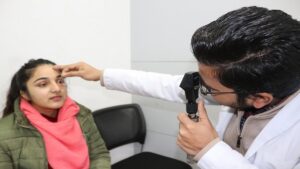
Woman suffering from vertigo or dizziness or other health problem of brain or inner ear.
An epilepsy disease in which the brain’s nerve cells don’t work as they should, which can cause seizures. Epilepsy can cause by a genetic disorder or a brain injury like a head injury or stroke.
During a seizure, a person acts, feels, and acts out in strange ways, and they may even lose consciousness. Between seizures, there aren’t many signs.
Epilepsy is often treat with surgery, devices, or changes to the way a person eats.
Epilepsy is a group of many different seizure disorders that all have the same thing in common: they start in the brain.
Any of us could have a single seizure at some point in our lives. This is not the same as having epilepsy, which is when the brain starts to shake.
Epileptic seizures may look like other types of seizures, but they don’t start in the brain. Some seizures is cause by health problems, like low blood sugar or a change in the rhythm of the heart. When a child has a fever, they may have what are called “febrile convulsions” (jerking movements). These are not the same thing as having a seizure.
If you have had two or more seizures that start in your brain, you may have epilepsy.
If you think you might have epilepsy, NICE says you should see a specialist within two weeks. A specialist is a doctor who is trained to diagnose and treat epilepsy.
You can get a diagnosis by telling what happen before, during, and after your seizures. Some types of fainting like epileptic seizures, and right before a person faints, they often feel cold and clammy and their vision blurs. But seizures from epilepsy happen quickly, and a person may not know when one is about to happen.
What kinds of treatments are there?
Epilepsy is sometimes call a long-term condition because many people have it for many years, if not their whole lives. Even though epilepsy can’t “cure,” seizures can usually be “control” (stop) so that it doesn’t affect their lives much or at all. Because of this, long-term seizure management is often the main focus of treatment.
Most people with epilepsy take anti-seizure medicine, which use to be call anti-epileptic drugs (AEDs). This medicine stops seizures from happening. Most people trust Pregabalin 50mg and Pregabalin 75 mg to treat epilepsy. People who can’t control their seizures with ASM, on the other hand, can try other treatments.
Choices for treatments
Epilepsy is usually only treat after a person has had a number of seizures and has been diagnosed with it. The diagnosis should be made by a specialist, preferably one who knows a lot about epilepsy. This is what NICE said to do (the National Institute for Health and Care Excellence).
In some rare cases, treatment might be thought about after only one seizure. Usually, this is only done if your doctor thinks you will have a lot more seizures. If this is the case, they may tell you to start treatment as soon as possible.
Medication
Anti-seizure medication (ASM), which use to be called anti-epileptic drugs (AEDs), works by controlling the electrical activity in the brain that causes seizures. It doesn’t cure epilepsy, and it isn’t use to stop a seizure that’s already happening. The best way to use ASM is to take it every day around the same time. With the right ASM, 70% of people (7 out of 10) could be free of seizures (stop having seizures).
Does my epilepsy put me at risk?
In every part of our lives, we take risks, but some of them are scarier than others. Risk is the chance that something bad, like loss or injury, will happen, and it is often link to uncertainty. Sometimes, taking a risk means trying something new and pushing yourself in a good way. But risk can also mean the chance of getting hurt, being in danger, or having your health hurt.
Because everyone with epilepsy is different, the risks that come with it depend on whether you are having seizures right now, how many and what kind of seizures you are having, how they are making you feel, and if you have any other health problems, like heart or breathing problems.
It can hard or scary to think about possible dangers to your health and safety. But it can helpful to look at risks if it helps you find ways to lower risks or make things safer. It might also make you feel more in charge and help you figure out which risks are important to you, so you can focus on what’s most important to you.
People with epilepsy are also at risk of getting hurt, having an accident, or getting hurt. You might also able to do the things you like and stay as independent as possible if you look into risk management.
If you have epilepsy, you are also fine with it or you may have questions or worries.
Your epilepsy and the way you live your life may seem like big problems. This information gives you a quick look at epilepsy and how to treat it. We also talk about sports and leisure, sex, drugs, social life, driving, getting a job, how you may feel about your epilepsy, how to get help, and how your friends can help you if you have a seizure.




